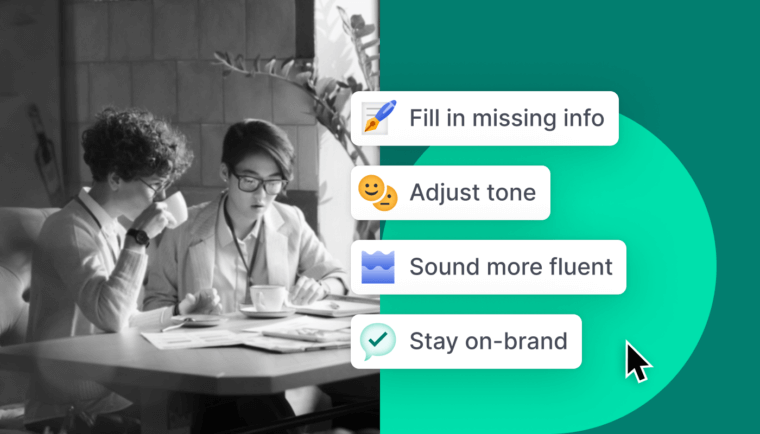
Emoji have become essential in our day-to-day digital communication—so much so that World Emoji Day was created to celebrate this language of images. Although emoji quickly became a mainstream way to insert nonverbal cues in personal conversations online or over SMS, using emoji in business communication was typically discouraged among professionals.
However, as businesses continue to evolve, with many supporting remote work that involves messaging platforms, communication in some industries has at times taken on a more casual tone. Using an emoji for business messages now serves as a paralinguistic way to express context, emotion, and tone at work.
How to use emoji in business communication
Even if your workplace culture involves the use of emoji in business communication, it’s still wise to be aware of how and when you use them. Some ways to use workplace emoji include:
- Enhancing status updates: Some platforms, like Slack, allow you to add an emoji—with or without text—to your status when you’re away from the computer, in a meeting, or on vacation.
- Conveying tone or context and deepening relationships: Including an emoji can enhance clarity and conciseness in your writing. Emoji also build friendly workplace relationships, which contribute to a cooperative team culture.
- Calling attention to marketing emails: Sometimes emoji are in line with a business’s brand and are used to convey a playful, fun tone in social media and marketing copy. You might use emoji in a business email, like in a subject line that’s marketing to a millennial audience or younger, for example, or in the caption of an Instagram post.
- Expressing your personality: Some people have go-to emoji that they relate to. Sharing these emoji in business communication can be a means of self-expression and a way for your team to learn how you’re feeling.
Regardless of when you choose to insert an emoji into your business writing, it’s also important to be aware of how you do it. Emoji can be interpreted differently, so choose emoji that elicit a simple meaning.
Effective emoji for business communication:
🙂 = smile
👏 = clap
🙌 = raised hands; nicely done
🎉 = celebrate
👍 = thumbs-up; sounds good
🗓️ = schedule; calendar
💡 = idea
Even though emoji are acceptable at your workplace, use them sparingly. Writing a brief message alongside an emoji gives the recipient more context about the information you’re sharing.
When not to use emoji in the workplace
With the exception of an intentional marketing campaign that leverages emoji to capture an audience’s attention, emoji shouldn’t be used in formal business communication, particularly in conversations that include third-party individuals. Some examples include:
- Client or partner introductions
- Contract negotiation emails
- Client-facing messaging channels
- Certain high-level individuals, depending on your company culture
Even if your company is open to using emoji in business communication, it’s best to avoid it when messaging someone you haven’t developed camaraderie with. An emoji, interpreted in the wrong way, can result in misunderstanding and possibly strain a work relationship.
For example, if you’re asking a coworker for a status update on a time-sensitive presentation, you might message: “So, will you be finishing that presentation today? 🙂.” The “slightly smiling” emoji might seem like a good way to soften a direct ask, but the recipient might read it as sarcasm.
If in doubt, mirroring the other person’s use of emoji in a similar context can help both parties stay on the same page.
5 examples of emoji in business communication
Below are a few examples of appropriate ways to use an emoji for business.
1 Messaging leadership on Slack
“I was thinking of innovative features for our mobile product, and I have an idea.💡”
2 Catching up with a coworker in a private message
“Hey! I watched your Zoom presentation this morning. The data you collected is fascinating—great job! 👏”
3 Emailing an employee you manage
“Hi Torrance,
Congratulations, you’ve been selected for the leadership team! 🥳 We’ll discuss what this means for you in terms of responsibilities and compensation on Monday, but I wanted to share the good news before you left for the weekend. Thank you for your contributions and for being a valuable part of this organization!”
4 Sending a marketing email to subscribers
Subject: PROMO $5 off lunch orders 👀
5 Updating your manager about your project list
Here’s a daily task status rundown:
✅ Call XYZ client about PO
✅ Released open call for photoshoot
🚫 Finalize meeting with partner vendor
👉 Waiting on their availability
Using emoji in work communication is a judgment call
Using emoji is so ingrained in computer-based language that you might be automatically inclined to use them as part of your workplace communication. Although it’s become more accepted in business, you’ll ultimately need to evaluate your company’s culture and use your best judgment.
Specifically, knowing your audience (i.e., your message’s recipient) and establishing mutual trust with that person is crucial to ensuring your emoji are received in the way you intended.






